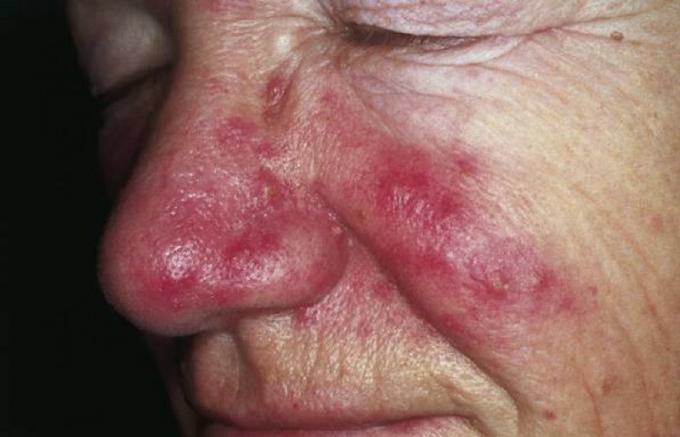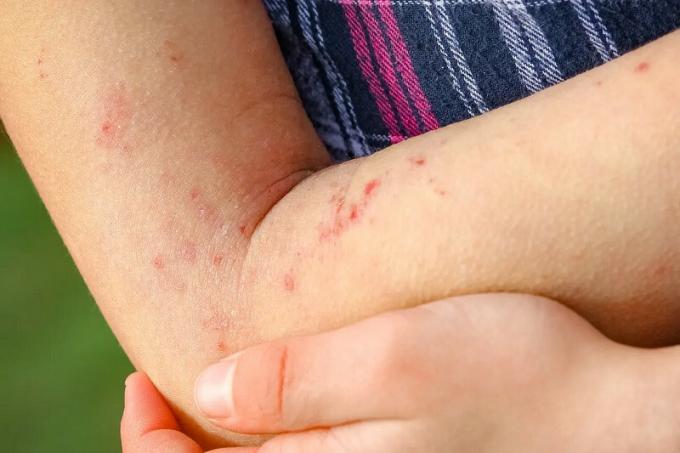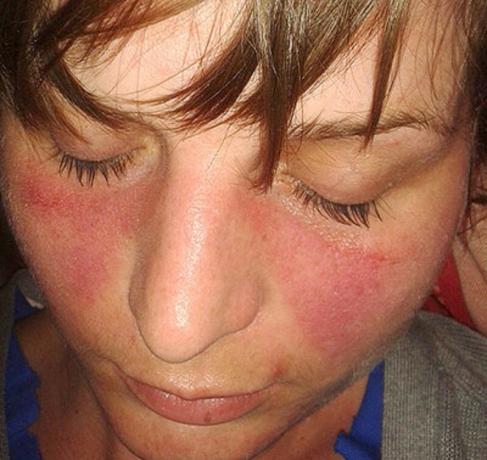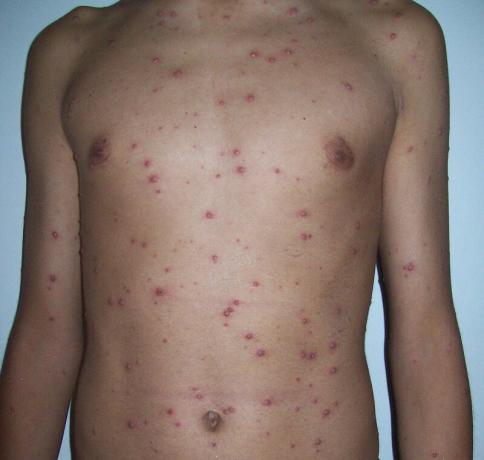Red spots on the skin: 25 possible causative diseases, and symptoms
There are many skin diseases, each with its own causes of appearance and also varied symptoms addressed from dermatology. However, among all the symptoms that they can present, there is one that usually recurs: red spots on the skin.
These spots do not have to indicate that there is a serious disease, in fact, sometimes they appear as the effect of some drug or stress, although in others it may be indicative of a disease as serious as cancer of the skin.
If these types of spots appear on our skin, it is advisable to go to a dermatologist to establish a diagnosis and make sure that nothing bad happens, and thus rule out any of the possible causes that below we will discover.
- Related article: "The 4 types of skin (and how to take care of them)"
Characteristics of red spots on the skin
The skin is the largest organ in the human body. Long, and never better said. If we skinned an adult of average height we would have more than two square meters in size, and a somewhat daunting scene, of course. The skin is the main barrier of our body since it prevents dangerous substances and pathogens from reaching the interior. In addition to its great protection function, it also allows us to receive information from the external environment since it contains the sense of touch, made up of cells receiving stimuli such as textures, pressure, pain, and even changes in temperature.
The anatomy and physiology of the skin make this organ very well protected, but it is not immune to suffering from pathologies. Constant exposure to outside threats, both in the form of pathogens and substances harmful, makes it possible to present pathologies and for that reason we speak of diseases dermatological. There are many skin pathologies, with characteristic symptoms, but one that recurs very often is the red spots..
The cause behind the red spots on the skin are many: infections, temperature changes, allergies, drug side effects, disorders autoimmune, stress... It should be noted that, on many occasions, it is a clinical sign that does not imply any seriousness, that there is no need to worry anxiously when seeing one, although yes go to a dermatologist to rule out any pathology.
Main causes of red spots on the skin
Red spots on the skin are the appearance of color changes in this organ. Areas appear in which, whether or not there is some type of lump or dermatological condition, the skin takes on a more or less intense reddish tone. These spots can be accompanied by other symptoms, such as itching, tingling, pain of varying intensity. These spots can be caused by various medical problems, which makes their treatment and severity very varied.
Next we are going to see the main pathologies that can cause the appearance of red spots on the skin.
1. Rosacea
Rosacea is a skin condition in which reddened areas appear on the face and in the visibility of blood vessels, although pimples filled with pus may also appear. There is a genetic predisposition to suffer from it and it is more common in middle-aged white women, especially of northern and eastern European origin, of Germanic and Slavic descent. There is no cure but there are treatments to relieve symptoms.

2. Allergic reaction
Allergic reactions are more common than it may seem. About 40% of the world's population suffers from someThe most common being allergies to mites, pollen, animal hair and food. These are excessive immune reactions to exposure to the allergen, a substance that does not have to be harmful to the body but the body interprets it as such.
Allergic skin reactions are very common and present with red spots. These stains can be prevented by avoiding exposure to the allergen and treating with antihistamines.
- Related article: "Anaphylaxis (Anaphylaxis): Symptoms, Causes, and Treatment"
3. Contact dermatitis
Contact dermatitis is inflammation and redness of the skin caused by contact with an allergen. The substance to which you are allergic causes an irritating reaction to the skin, making it not only the red spot appears but also itching, dryness, scales or even blisters.
- You may be interested in: "The 8 types of acne and their characteristics"
4. Bites
Insect bites can produce red spots where they have been bitten. Its appearance is due to the inflammatory reaction of the body and by the action of some substances that biting insects release. Most bites are usually treated topically, with ointments readily available at any pharmacy.
5. Side effect of a medication
Drugs are not safe, naturally. In addition to their therapeutic effect, they have several adverse effects and in many medications red spots on the skin are one of them. Skin side effects are common, but rarely serious.
6. Excess stress
As surprising as it may seem to more than one, stress can cause red spots to appear on the skin. Some people, when they are going through an emotionally stressful situation, may somatize, manifesting physical symptoms and one of them is redness of the skin.
- Related article: "Types of stress and their triggers"
7. Atopic dermatitis or eczema
Atopic dermatitis, also known as eczema or eczema, is a common skin disease in children who characterized by the appearance of itchy red spots. Its cause is usually genetic, making the skin unable to protect itself well from the weather and making it more sensitive to irritation. There is no cure but there are ointments to relieve itching.

8. Seborrheic eczema
Seborrheic eczema is a variety of dermatitis that usually occurs on the scalp, causing the red spots to appear on the skin of the head mostly. It can also manifest itself in the mouth, nose, and ears.
9. Diaper rash
Diaper rash is a disease of babies, being one of the most common among neonatal diseases. As the name suggests, This consists of the skin in the area covered by the diaper becoming red and itchy. This is caused by bacteria in the stool, which produce ammonia, a chemical that is irritating to the skin. It is easily avoidable, changing the baby's diapers as soon as possible and, if it appears, treating it with ointments that relieve itching.
10. Tub
Ringworm is a skin disease caused by fungi that colonize the skin and produce lesions that are accompanied by red spots. Their spots usually appear on the back and shoulders. It is not serious or contagious, but it affects the quality of life of the injured person, although, fortunately, there are antifungal ointments. There are also specific drugs ingested orally, although they are reserved for the most severe cases.
11. Infectious cellulitis
Infectious cellulitis (not to be confused with edematous cellulitis) is a dermatological disease that occurs due to a bacterial infection and it can have serious complications. This skin infection is most common on the legs, caused mainly by bacteria such as staph or streptococci, which enter through a cut in the skin. Red spots appear in the area of the cut.
It must be treated quickly with antibiotics since the bacteria can spread throughout the body and be life-threatening.
- Related article: "The 4 types of pathogens (and their characteristics)"
12. Scabies
Scabies is a dermatological disease caused by the Sarcoptes scabiei, a mite that parasitizes the skin and that is transmitted by skin-to-skin contact. When this mite bites us, symptoms appear in the form of red spots and itching, which worsens at night. The star treatment for scabies consists of creams that are applied to the skin and manage to destroy both the mite and its eggs.
13. Skin cancer
Skin cancer is a disease that occurs when a malignant tumor appears in the epidermis. Its main cause is excessive exposure to solar radiation. It is the fifth most common cancer disease, with about 1 million cases diagnosed annually globally. Red spots can be a clinical sign of its appearance. If it is detected early, it can be treated by surgery, with a 98% chance of survival.
- You may be interested in: "Types of cancer: definition, risks and how they are classified"
14. Impetigo
Impetigo is a very contagious and common skin disease in children. Its symptoms include the appearance of sores around the mouth and nose that, over time, become scabs.. It is caused by a bacterial infection that triggers inflammatory reactions, which are responsible for the red spots of the disease. Its treatment is quite effective, because as it is caused by bacteria, the main way to treat it is with antibiotics.
15. Lupus
Systemic lupus erythematosus it is an autoimmune disease. In this pathology, immune cells, due to hereditary programming failures, attack healthy cells in multiple organs and tissues, including the skin. In fact, the skin is one of the most commonly attacked regions, where the immune reaction causes the appearance of reddish rashes on the face, especially the cheeks and nose.
As its cause is genetic, it cannot be prevented or cured, but fortunately there are treatments such as anti-inflammatories, immunosuppressants and corticosteroids, aimed at softening the symptomatology.

16. Candidiasis
Candidiasis is a skin disease caused by a fungus, specifically the Candida albicans. This fungus normally inhabits our body but, when certain conditions are met, it can behave as a pathogen in our body. When this happens, it causes the appearance of reddish skin rashes that are very itchy. Treatment consists of applying antifungal creams to kill the fungus.
17. Kawasaki disease
Kawasaki disease mainly affects children, under 5 years old, and occurs in the form of inflammation of the walls of the medium arteries. It tends to affect the coronary arteries, which supply blood to the heart muscle, which is why it is considered a medical emergency if it occurs. It is not known what causes it.
This medical condition is also called mucocutaneous lymph node syndrome because it also affects the lymph nodes, which swell during an infection. It also affects the skin and mucous membranes inside the mouth, nose, and throat. The tongue acquires a very red hue and swells, there is a high fever, swelling, red palms and soles of the feet and red eyes.
Although its symptoms can be frightening and it is considered a serious medical condition, it is usually treatable and most children recover from it without serious sequelae.
18. Chickenpox
Varicella is a highly contagious disease, caused by the infection of the varicella-zoster virus in skin cells. It usually occurs in childhood because, after the first exposure, lifelong immunity develops.
It is the sixth most contagious disease in the world and its main symptoms include the appearance of a rash with red or pink papules. There is no treatment to eliminate the virus other than waiting for the body to fight the infection. However, there is a vaccine, and it is preferable to present the disease because in adults it can be very serious.

19. Measles
Measles is a life-threatening childhood disease that to date has not been fully eradicated, despite what many believe. This contagious disease continues to be responsible for more than 100,000 child deaths each year. and it is caused by an airborne virus of the Paramyxovirus family. Among its main symptoms we find the reddish rash, although there is a risk of serious complications that means that 10% of people who suffer from it do not survive.
There is no treatment for measles, but there is a vaccine.
20. Psoriasis
Psoriasis is a dermatological condition that occurs when the body produces too many skin cells, accumulating and causing red spots to form. There is no cure for this disease and it is suffered chronically, although there are drugs to alleviate the symptoms.

21. Rubella X
Rubella is a childhood disease of viral origin, similar to measles but not as serious or contagious. In fact, it can be very mild, so much so that there are no symptoms. However, when they do appear, their main clinical sign is the appearance of a pink rash. It is a mild disease for which there is no cure, but there is a vaccine to prevent infection.
22. Scarlet fever or scarlet fever
Scarlet fever can appear both at the same time and after it has occurred a strep throat infection. In this disease, red skin rashes can appear all over the body, except the hands and feet. The rashes are made up of small bumps that feel like sandpaper. The tongue takes on a bright red hue.
23. Fifth illness
The fifth disease, more properly called infectious erythema, is a common pathology in babies caused by parvovirus. The reason why it is called that is that historically it was the disease number five on the list of childhood pathologies characterized by the appearance of a rash. It is also called the slap disease.
The spots on the skin appear as a round and shiny rash on the cheeks They present with headache, fatigue, low fever, sore throat, diarrhea, nausea, and runny nose. On the arms, legs and upper body there are rashes with pinpoint patterns.
24. Miliaria
Heat rash is also known as heat rash.. This skin disease appears when the sweat ducts, that is, the pores of the skin, become clogged and sweat is trapped. Heat rash occurs when clogged pores (sweat ducts) trap sweat under the skin. Red spots on miliaria are small, usually accompanied by small red, burning balls that appear mostly on the face, neck, back, chest, and thighs.
25. Zika virus
Zika causes gently raised reddish spots that are itchy and they usually appear about 4 days after being bitten by the mosquito that transmits this virus. The spots first appear on the face and then spread over the rest of the body in a few hours, lasting about 5 days.
